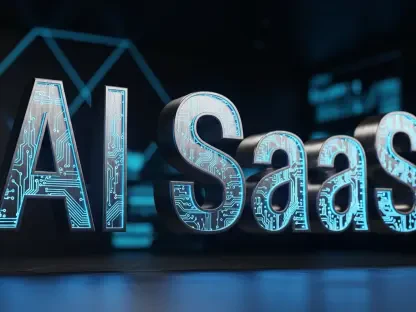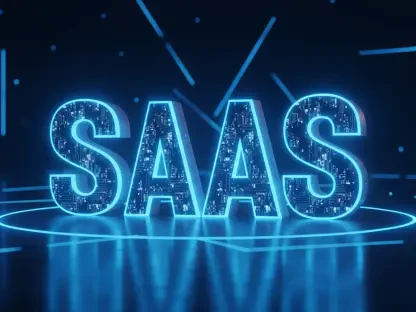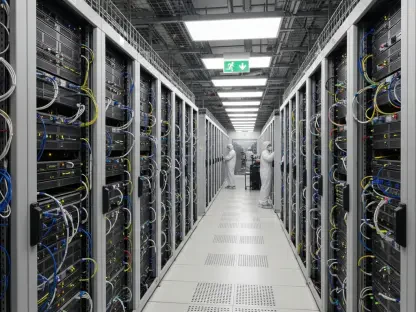Imagine a market where software giants, long dominant in their field, suddenly face a new contender wielding the power of artificial intelligence to redefine the rules of engagement. This is the reality for the software-as-a-service (SaaS) industry today, as OpenAI, once known primarily for its AI models, storms into direct competition with established players like HubSpot and Salesforce. With groundbreaking tools that promise unparalleled personalization and efficiency, OpenAI’s entry has sparked a seismic shift, sending stock prices tumbling and forcing incumbents to rethink their strategies. This report dives into the evolving dynamics of the SaaS landscape, exploring how AI-driven innovation is challenging traditional models and what it means for the future of enterprise software.
The SaaS Industry Landscape: A Shifting Terrain
The SaaS market stands as a cornerstone of the global economy, experiencing rapid expansion with revenues projected to grow significantly over the coming years. This sector, driven by the shift to cloud-based solutions, supports businesses of all sizes by offering scalable, subscription-based software that eliminates the need for costly on-premises infrastructure. From small startups to multinational corporations, companies rely on SaaS for critical operations, making it an integral part of modern business ecosystems.
Key segments such as customer relationship management (CRM), marketing automation, and sales enablement dominate the industry, addressing core needs like client engagement and revenue generation. CRM platforms streamline interactions with customers, while marketing automation tools enhance campaign efficiency, and sales enablement solutions empower teams to close deals faster. These areas collectively form the backbone of digital transformation strategies across industries.
Major players like HubSpot, Salesforce, Klaviyo, and DocuSign have shaped the competitive landscape with robust offerings that cater to diverse business needs. HubSpot excels in inbound marketing and CRM for mid-size firms, Salesforce leads in enterprise-grade solutions, Klaviyo focuses on email marketing, and DocuSign pioneers digital signatures. However, the rise of emerging technologies, particularly artificial intelligence, is disrupting traditional SaaS models, introducing new competitive dynamics that threaten to upend long-standing market hierarchies.
OpenAI’s Strategic Pivot: A Game-Changer in SaaS
Rise of AI-Native Solutions
OpenAI has dramatically shifted its focus from being a provider of foundational AI models to becoming a direct competitor in the SaaS arena with innovative tools like Inbound Sales Assistant and Tailor Assist. These applications target critical business functions such as sales support and marketing personalization, positioning OpenAI as a formidable rival to established software vendors. This transition marks a significant departure from merely supplying technology to crafting end-to-end solutions.
Unlike AI-enhanced software, which integrates artificial intelligence as an add-on to existing platforms, AI-native applications are built from the ground up with AI at their core, offering seamless automation and adaptability. This fundamental difference allows for superior performance in areas like customer interaction and data processing, potentially outpacing traditional offerings that struggle to retrofit AI capabilities into legacy systems.
Current trends underscore the disruptive potential of these tools, with hyper-personalization enabling tailored customer experiences, DIY solutions empowering businesses to customize workflows, and a broader shift toward AI-driven processes that minimize human intervention. Such advancements suggest that companies adopting these technologies could gain significant advantages over competitors clinging to conventional approaches.
Market Impact and Growth Prospects
The market response to OpenAI’s entry was immediate and pronounced, with HubSpot seeing a 7.2% stock decline on October 1, followed by even sharper drops for Klaviyo at 12% and other players like Braze and DocuSign. This reaction reflects investor concerns about the viability of traditional SaaS models in the face of AI-driven alternatives that promise greater efficiency and lower costs. The sell-off signals a broader unease about market share erosion among established firms.
Projections indicate that OpenAI’s revenue could reach $3.4 billion this year, fueled by enterprise agreements and direct sales of its SaaS applications. Strategic partnerships, such as those with technology leaders like Nvidia for AI infrastructure, further bolster this growth trajectory, enabling faster deployment and scalability for corporate clients. These figures highlight the aggressive expansion and market confidence in OpenAI’s offerings.
Looking ahead, this pivot is likely to reshape competitive landscapes, with potential shifts in market share as businesses gravitate toward AI-native solutions. Investor sentiment may remain volatile as the sector adjusts to these new entrants, but the long-term outlook suggests that companies embracing such innovation could redefine industry standards and capture significant value in the evolving ecosystem.
Challenges for Incumbents: Navigating the AI Disruption
Traditional SaaS giants now face intense competitive pressures as OpenAI’s market entry threatens to disrupt their dominance. The speed and sophistication of AI-native tools challenge the relevance of existing platforms, pushing companies to accelerate their own innovation cycles. Failure to adapt risks losing customers to more agile, technology-forward competitors.
Specific hurdles include the risk of obsolescence for legacy systems that cannot easily integrate advanced AI, alongside the high costs associated with developing or acquiring such capabilities. Mid-size players, in particular, face a squeeze as they lack the resources of larger firms to invest heavily in transformation, yet must compete with the cutting-edge offerings of new entrants like OpenAI.
To counter these threats, incumbents are exploring strategies such as rapid product enhancements and strategic alliances. For instance, rolling out AI-centric updates and partnering with technology providers can help maintain relevance. Emphasizing unique value propositions and customer loyalty programs also offers a pathway to weather the storm, though the road ahead remains fraught with uncertainty for many in the sector.
Regulatory and Ethical Hurdles in an AI-First Era
The integration of AI into SaaS brings with it a complex regulatory landscape, particularly concerning data privacy and market competition. Governments and oversight bodies are increasingly scrutinizing how user information is handled, with mandates emerging to ensure transparency and security. These regulations pose compliance challenges for companies leveraging vast datasets to train AI models.
Legal battles, such as antitrust lawsuits like the one filed by xAI against OpenAI, highlight tensions over market dominance and fair practices. Additionally, a court order earlier this year mandating user data segregation has forced adjustments in operational frameworks, impacting how SaaS providers design and deploy their solutions. Such rulings underscore the legal risks inherent in this rapidly evolving field.
Beyond compliance, ethical considerations are paramount to maintaining customer trust. Issues surrounding bias in AI algorithms and the responsible use of technology must be addressed to avoid reputational damage and potential penalties. As the industry moves toward an AI-first approach, balancing innovation with accountability will be critical for sustained success and public confidence.
The Future of SaaS: An AI-Driven Horizon
OpenAI’s expansion into SaaS signals profound long-term implications, including potential market consolidation as smaller players struggle to differentiate in an AI-dominated landscape. The rise of AI agents, capable of autonomously handling complex tasks, could further streamline business operations, reducing reliance on traditional software interfaces and reshaping vendor-client relationships.
Emerging opportunities also include innovative pricing models based on outcomes rather than subscriptions, aligning costs with tangible business results. Proactive AI solutions that anticipate needs and optimize processes before issues arise are gaining traction, promising to enhance efficiency across sectors. These developments point to a future where adaptability becomes a core competitive advantage.
Global economic conditions, technological advancements, and shifting consumer expectations will continue to influence this trajectory. Economic downturns may slow investment in new tools, while breakthroughs in AI capabilities could accelerate adoption. Meanwhile, demand for personalized, data-driven solutions will push providers to innovate relentlessly, ensuring that the SaaS landscape remains dynamic and ever-evolving.
Conclusion
Reflecting on the seismic shifts that unfolded with OpenAI’s entry into the SaaS market, it becomes clear that the industry has entered a new era of competition and innovation. The immediate impact on giants like HubSpot and Salesforce underscores the urgency for transformation, while the broader adoption of AI-native solutions hints at a fundamental reimagining of enterprise software. As challenges mount, from regulatory scrutiny to technological hurdles, the resilience of traditional players is tested like never before.
Looking ahead, stakeholders must prioritize strategic investments in AI integration to stay competitive, focusing on seamless adoption that delivers measurable value. Building financial resilience through diversified revenue streams and cost management will be essential to navigate market volatility. Additionally, keeping a close eye on regulatory developments will help mitigate risks and ensure compliance in an increasingly complex environment. By embracing these steps, companies can position themselves not just to survive but to thrive in the transformed SaaS reality that lies ahead.









